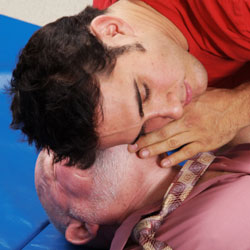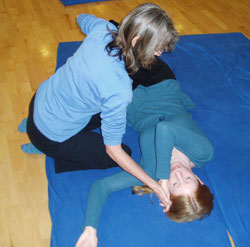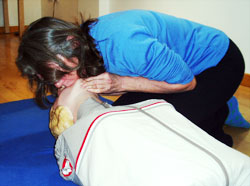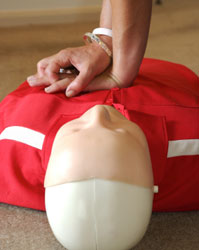Adult BLS sequence
 Basic life support consists of the following sequence of actions:
Basic life support consists of the following sequence of actions:
1 Make sure the victim, any bystanders, and you are safe.
2 Check the victim for a response.
- Gently shake his shoulders and ask loudly, ‘Are you all right?'
3 A If he responds:
- Leave him in the position in which you find him provided there is no further danger.
- Try to find out what is wrong with him and get help if needed.
- Reassess him regularly.
3 B If he does not respond:
- Shout for help.
- Turn the victim onto his back and then open the airway using head tilt and chin lift: Place your hand on his forehead and gently tilt his head back. With your fingertips under the point of the victim's chin, lift the chin to open the airway.
4 Keeping the airway open, look, listen, and feel for normal breathing.
- Look for chest movement.
- Listen at the victim's mouth for breath sounds.
- Feel for air on your cheek.
In the first few minutes after cardiac arrest, a victim may be barely breathing, or taking infrequent, noisy, gasps. Do not confuse this with normal breathing.
Look, listen, and feel for no more than 10 sec to determine if the victim is breathing normally. If you have any doubt whether breathing is normal, act as if it is not normal.
5 A If he is breathing normally:
- Turn him into the recovery position (see below).
- Summon help from the ambulance service by mobile phone. If this is not
possible, send a bystander. Leave the victim only if no other way of obtaining - help is possible.
- Continue to assess that breathing remains normal. If there is any doubt
about the presence of normal breathing, start CPR (5B).

5 B If he is not breathing normally:
- Ask someone to call for an ambulance and bring an AED if available or, if you are on your own, do this yourself; you may need to leave the victim. Start chest compression as follows:
- Kneel by the side of the victim.
- Place the heel of one hand in the centre of the victim's chest.
- Place the heel of your other hand on top of the first hand.
- Interlock the fingers of your hands and ensure that pressure is not applied over the victim's ribs. Do not apply any pressure over the upper abdomen or the bottom end of the bony sternum (breastbone).
- Position yourself vertically above the victim's chest and, with your arms straight, press down on the sternum 5 - 6 cm.
- After each compression, release all the pressure on the chest without losing contact between your hands and the sternum.
Repeat at a rate of 100 to 120 times a minute.
- Compression and release should take an equal amount of time.
6 A Combine chest compression with rescue breaths.

- After 30 compressions open the airway again using head tilt and chin lift.
- Pinch the soft part of the victim's nose closed, using the index finger and thumb of your hand on his forehead.
- Allow his mouth to open, but maintain chin lift.
- Take a normal breath and place your lips around his mouth, making sure that you have a good seal.
- Blow steadily into his mouth whilst watching for his chest to rise; take about one second to make his chest rise as in normal breathing; this is an effective rescue breath.
- Maintaining head tilt and chin lift, take your mouth away from the victim and watch for his chest to fall as air comes out.
- Take another normal breath and blow into the victim's mouth once more to give a total of two effective rescue breaths. Then return your hands without delay to the correct position on the sternum and give a further 30 chest compressions.
- Continue with chest compressions and rescue breaths in a ratio of 30:2.
- Stop to recheck the victim only if he starts to show signs of regaining consciousness, such as coughing, opening his eyes, speaking, or moving purposefully AND starts to breathe normally; otherwise do not interrupt resuscitation.
If your rescue breaths do not make the chest rise as in normal breathing, then before your next attempt:
- Check the victim's mouth and remove any visible obstruction.
- Recheck that there is adequate head tilt and chin lift.
- Do not attempt more than two breaths each time before returning to chest compressions.
If there is more than one rescuer present, another should take over CPR about every 1-2 min to prevent fatigue. Ensure the minimum of delay during the changeover of rescuers.
6 B Chest-compression-only CPR.
- If you are not able, or are unwilling, to give rescue breaths, give chest compressions only.
- If chest compressions only are given, these should be continuous at a rate of 100-120 a minute.
- Stop to recheck the victim only if he starts to show signs of regaining consciousness, such as coughing, opening his eyes, speaking, or moving purposefully AND starts to breathe normally; otherwise do not interrupt resuscitation.
7 Continue resuscitation until:
- qualified help arrives and takes over,
- the victim starts breathing normally, or
- you become exhausted.
